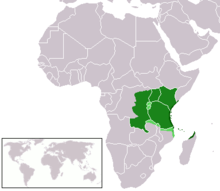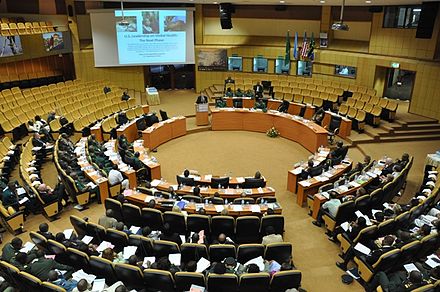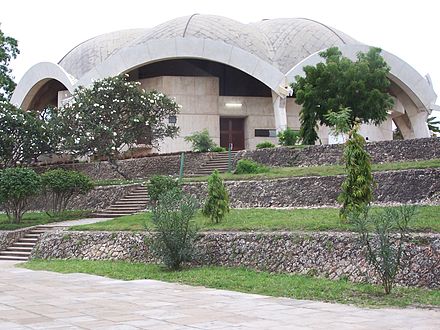Portal:Tanzania
 The Tanzania Portal
Tanzania, officially the United Republic of Tanzania, is a country in East Africa within the African Great Lakes region. It is bordered by Uganda to the north; Kenya to the northeast; the Indian Ocean to the east; Mozambique and Malawi to the south; Zambia to the southwest; and Rwanda, Burundi, and the Democratic Republic of the Congo to the west. Mount Kilimanjaro, Africa's highest mountain, is in northeastern Tanzania. According to the 2022 national census, Tanzania has a population of nearly 62 million, making it the most populous country located entirely south of the equator. Many important hominid fossils have been found in Tanzania, such as 6-million-year-old Pliocene hominid fossils. In the Stone and Bronze Age, prehistoric migrations into Tanzania included Southern Cushitic speakers who moved south from present-day Ethiopia; Eastern Cushitic people who moved into Tanzania from north of Lake Turkana about 2,000 and 4,000 years ago; and the Southern Nilotes, including the Datoog, who originated from the present-day South Sudan–Ethiopia border region between 2,900 and 2,400 years ago. These movements took place at about the same time as the settlement of the Mashariki Bantu from West Africa in the Lake Victoria and Lake Tanganyika areas. In the late 19th century, the mainland came under German rule as German East Africa, and this was followed by British rule after World War I when it was governed as Tanganyika, with the Zanzibar Archipelago remaining a separate colonial jurisdiction. Following their respective independence in 1961 and 1963, the two entities merged in 1964 to form the United Republic of Tanzania. Tanganyika joined the British Commonwealth and Tanzania remains a member of the Commonwealth as a unified republic. Tanzania is mountainous and densely forested in the north-east, where Mount Kilimanjaro, the highest mountain in Africa and the highest single free-standing mountain above sea level in the world, is located. Three of Africa's Great Lakes are partly within Tanzania. To the north and west lie Lake Victoria, Africa's largest lake, and Lake Tanganyika, the continent's deepest lake, known for its unique species of fish. To the south lies Lake Malawi. The eastern shore is hot and humid, with the Zanzibar Archipelago just offshore. The Menai Bay Conservation Area is Zanzibar's largest marine protected area. The Kalambo Falls, located on the Kalambo River at the Zambian border, is the second-highest uninterrupted waterfall in Africa. Tanzania is one of the most visited tourist destinations for safaris. Selected article -Swahili, also known by its local name Kiswahili, is a Bantu language originally spoken by the Swahili people, who are found primarily in Tanzania, Kenya and Mozambique (along the East African coast and adjacent littoral islands). The number of current Swahili speakers, be they native or second-language speakers, is estimated to be over 200 million, with Tanzania known to have most of the native speakers. Swahili has a significant number of loanwords from other languages, mainly Arabic, as well as from Portuguese, English and German. Around fifteen percent of Swahili vocabulary consists of Arabic loanwords, including the name of the language (سَوَاحِلي sawāḥilī, a plural adjectival form of an Arabic word meaning 'of the coasts'). The loanwords date from the era of contact between Arab traders and the Bantu inhabitants of the east coast of Africa, which was also the time period when Swahili emerged as a lingua franca in the region. (Full article...)General images -The following are images from various Tanzania-related articles on Wikipedia.
This month in Tanzanian history
Wildlife of Tanzania -_1.jpg/440px-Afrikanische_Büffel_(Syncerus_caffer)_1.jpg) Credit: Haplochromis
The African buffalo, affalo or cape buffalo (Syncerus caffer) is a large African bovid. It is not closely related to the slightly larger wild Asian water buffalo, but its ancestry remains unclear. Owing to its unpredictable nature which makes it highly dangerous to humans, it has not been domesticated, unlike its Asian counterpart, the domestic Asian water buffalo. Did you know ...
CategoriesWikiProjectsRecognised contentSelected panorama -Mikumi National Park, a national park in Mikumi, near Morogoro, Tanzania. The park was established in 1964, currently covers an area of 3230 km² and is the fourth largest in the country. The landscape of Mikumi is often compared to that of the Serengeti. The road that crosses the park divides it into two areas with partially distinct environments. The area north-west is characterized by the alluvial plain of the river basin Mkata. The vegetation of this area consists of savannah dotted with acacia, baobab, tamarinds, and some rare palm. In this area, at the furthest from the road, there are spectacular rock formations of the mountains Rubeho and Uluguru. The southeast part of the park is less rich in wildlife, and not very accessible.
Uganda–Tanzania War -Articles here focus upon aspects of the Uganda–Tanzania War. These are all Good articles that meet a core set of high editorial standards.
The Battle of Lira was one of the last battles in the Uganda–Tanzania War, fought by Tanzania and its Uganda National Liberation Front (UNLF) allies, against Uganda Army troops loyal to Idi Amin on 15 May 1979. The Tanzanian-led forces easily routed Lira's garrison of Amin loyalists, and then intercepted and destroyed one retreating column of Uganda Army soldiers near the town. Idi Amin had seized power in Uganda in 1971 and established a brutal dictatorship. Seven years later he attempted to invade neighbouring Tanzania to the south. The attack was repulsed, and the Tanzanians launched a counter-attack into Ugandan territory. After a number of battles, Amin's regime and military largely collapsed, whereupon Tanzania and its Ugandan allies of the UNLF began to mop up the last pro-Amin holdouts in Uganda's east and north. One of these was the town of Lira, whose capture was entrusted to a force consisting of the Tanzanian 201st Brigade and the UNLF's Kikosi Maalum force. (Full article...)TopicsSelected picture -Related portalsThings you can doAssociated WikimediaThe following Wikimedia Foundation sister projects provide more on this subject:
Discover Wikipedia using portals | ||||




.jpg/440px-Olduvai_stone_chopping_tool_(cropped).jpg)
_and_her_husband_Louis_Seymour_Bazett_Leakey_(1903-1972).jpg/440px-Mary_Douglas_Nicol_Leakey_(1913-1996)_and_her_husband_Louis_Seymour_Bazett_Leakey_(1903-1972).jpg)





































.jpg/440px-FIB-training-22_(9311333487).jpg)



















